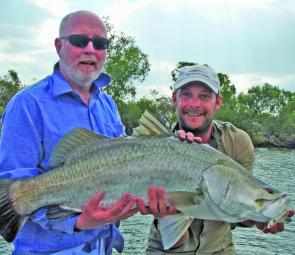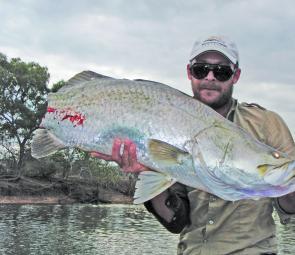A few good wet seasons strung together in recent years have seen good numbers of barra on the chew right throughout winter. A period of often quiet fishing further south where water temperatures drop more noticeably, Cape York can still see some great fishing right through winter and into spring.
Playing the numbers game will never be quite as exciting as it is earlier and later in the year, however this period of cooler weather from June – September can be used to target larger fish which concentrate in deeper stretches of river and around structure.
Deep rock bars, sandy holes and snags are great places to begin searching and a sounder will help pick up bait and larger fish. We had a brilliant session recently on the west coast in a relatively featureless stretch of river. A large snag washed down in this year’s wet had lodged in around 8-10ft of water adjacent to a rubble bottom. Slowing down to check out the snag, a pretty picture showed on the sounder just wide of it, bait balled up over a 10m stretch!
A few random casts around the snag produced nothing so we decided to troll up the line against a slowly receding tide. Just wide of the bait school we got smashed on the way past, a leaping barra and solid fingermark eagerly boated. Next pass, double hook-up again on barra, so we gently lowered the pick and began tossing plastics and deep divers long and working them slowly back to the boat. Barra after barra with some absolute beauties thrown in made the next two hours memorable indeed.
Venturing right up some of the west coast rivers can make for difficult fishing this time of year, with snags and drains sometimes devoid of the fish they held earlier in the season. But rest assured, the large, well placed snags such as on junctions and deep holes, will hold resident fish. Sometimes they just need more encouragement to come out.
Flogging a likely spot for ten minutes before even getting a touch can be daunting, but persisting in likely spots can often bring about a short and intense bite. If you get a knock or strike from a barra, concentrate all your efforts on that one spot with follow up casts. Starting them off is half the battle and time and time again I see anglers amazed at a hot barra bite occurring well after they would have moved on.
This time of year, if you find fish either trolling or casting, anchor your boat intelligently to best cast around the area. Guaranteed you will catch more fish at the end of the day than simply drifting past. A good example occurred recently as we drifted down a snaggy bank which dropped away towards a submerged rock bar. A tentative pluck from a barra was registered well out from the bank, so the anchor went down.
Nothing else was forthcoming on the hard bodies, so we tied on a couple of shad tail style soft plastics and wound them back steadily past the snags and then let them sink towards the rocks. It turned out there were some thumper barramundi holding on the upstream side of the rocks. A fish just over the 1m mark ate a tiny plastic and came careering out of the water. A great fight ensued and all went well; the female barra released and swimming strongly down into the green water below.
| It made the fatal mistake of resting up under a big log near the shore. We watched horrified half an hour later as thrashing on the water’s edge was followed by the terrible big bill of a saw shark punching our released barra against | the bank. The shark managed to latch hold of its tail and bit off about 25cm before the barra kicked off into the current. Unable to submerge itself, we motored over and retrieved it for the second time! Any deep holes in as otherwise shallow river will hold some serious predators this time of year and are well worth checking out. |
|---|

Large, well placed snags are the spots to target for big barra such as this shiny specimen.

The work of a big saw shark on a metre plus barra only just released!




